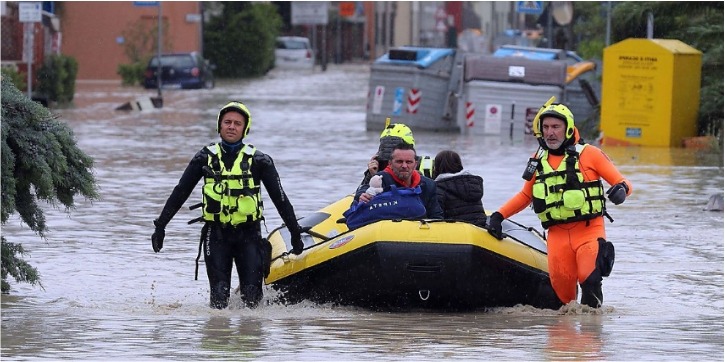
The northern Italian regions of Emilia Romagna and Marche are reeling from the aftermath of severe flooding caused by torrential rain. The destructive storm front that swept through the area has claimed the lives of at least nine individuals and forced the evacuation of a staggering 13,000 people. With rivers bursting their banks and relentless downpours inundating towns and cities, the scale of the disaster is becoming increasingly evident.
The town of Forli, situated in Emilia Romagna, is grappling with partial submersion as the Montone river overflowed its boundaries. However, the devastation is not limited to Forli alone. Cesena, Faenza, Senigallia, Riccione, and Rimini are among the other urban areas that have been severely affected by flooding, leaving residents in dire straits.
The gravity of the situation is further compounded by the fact that 37 communities find themselves completely submerged. A total of 21 rivers have already breached their banks, and another 22 are precariously close to overflowing. The Apennine municipalities in Emilia Romagna have witnessed a staggering 250 landslides, with 150 classified as serious. In Faenza, desperate individuals sought refuge on their rooftops, awaiting rescue from helicopters summoned to airlift them to safety.
Power outages and disrupted telephone connections have plunged affected regions into further chaos. In response, authorities in Bologna have issued a stern advisory, urging citizens to drive only in cases of absolute necessity. Sections of the A14 motorway near Pesaro have been closed, adding to the logistical challenges faced by residents and emergency response teams.
To coordinate rescue and relief efforts, Interior Minister Matteo Piantedosi promptly arrived in Bologna, where the situation remains precarious. Local mayors, including those of Bologna, Faenza, Ravenna, and Forlì, have taken the precautionary measure of keeping schools closed due to the looming threat of additional storms.
Transportation networks have also been severely disrupted. Rail services connecting Forli, Rimini, and Ravenna have ground to a halt, leaving commuters stranded and further exacerbating the logistical nightmare. Train connections have been discontinued, leading to numerous cancellations and leaving travelers stranded.
In anticipation of high waves and the potential for further damage, coastal municipalities such as Ravenna and Cervia have implemented bans on beach access. The threat of flooding and landslides looms large in the provinces of Pesaro and Urbino, adding to the distress of residents already grappling with the calamitous situation.
In light of the ongoing crisis, authorities have urged residents in Emilia Romagna to avoid unnecessary travel and instead work from the safety of their homes. The region has witnessed an astonishing deluge of rainfall in a matter of hours, equivalent to what would typically be expected over the course of several months. Meanwhile, in Trieste, wind gusts reaching speeds of 120 kilometers per hour have been recorded, prompting concerns about potential flooding in Venice.
Recognizing the urgent need for assistance, the government has swiftly allocated ten million euros to address immediate expenses and emergencies resulting from the floods. Prime Minister Giorgia Meloni has assured affected regions of unwavering support during this challenging period. The impact of the severe storms extends beyond Emilia Romagna and Marche, with Tuscany also grappling with disruptions in ferry connections as a result of the inclement weather.
Meteorologists, meanwhile, have issued a sobering forecast, predicting an additional ten days of unsettled weather. As the central Adriatic braces for more severe storms, a Tunisian hurricane is expected to make landfall on Thursday, further compounding the ongoing crisis. With the situation still unfolding, the affected regions must
